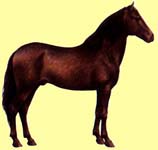|
|
Alter Réal |
|
|
Alter Réal |
| Group | Warmblood |
|---|---|
| Influences |
|
| Characteristics |
|
| Colors |
|
| Odd Facts |

The Altér Real (pronounced Al-tare Ray-al) is a horse of the meso-dolichomorphic type originating in the 18th century in the hot temperate environment of Alter, Portugal. This breed was developed as a mount for royalty, and the name so implies this. The purpose of the Altér Real was to present its rider in heroic form. This horsse was schooled in the classical Spanish Riding School, and performed well due to its ideal spirit and action.
Three hundred of the finest Andalusian mares were selected from Jerez de la Frontera (Spain's most famous breeding center), and imported in 1746 by the House of Braganzam with a view of establishing a national stud. Founded in 1748 by the ruling house at Villa de Portel (in the province of Alentejo in southern Portugal), the Stud was moved to Alter in 1756. From the Spanish Horse, its relative, the Lusitano, inherited high courage and distinctive character. Flourishing, the Stud provided horses for the Royal Menège at Lisbon, and the Altér-Real was used later in the eighteenth century for famous performances of high school exercises in Lisbon.
The Napoleonic invasion and subsequent events nearly eliminated the Altér Real as a breed. The popularity of high school equisition began to fail and the stud was disbanded with the coming of Neopleon. The Altér Real began to be crossed extensively with other breeds. In the early 19th century, many horses were lost or stolen when Napoleon's troops sacked the stud. In 1834, the culminating disasters at Alter resulted in the abolition of the Royal Stables.
By the beginning of the 20th century, the Altér Real began to be appreciated for its value as a high-school horse again. Queen Maria Pia began a reorganizatioon attempt in the late 19th century in the breeding of Altér Real horses. Foreign blood was introduced under Queen Maria's efforts. The breed was seriously contaminated when English Thoroughbred, Norman, Hanoverian, and especially Arabian blood was introduced. Each experiment was unsuccessful and nearly ruined the breed. As a result of subsequent introduction of Andalusian horses (Zapata strain), which continued into the twentieth century by government intervention, the breed has been reestablished.
After the advent of the Republic in 1910, the stud archives were destroyed, and not until 1932 did constructive efforts begin to reestablish the Altér Real. The Ministry of Economy in Portugal took over the selective breeding program and began to maintain accurate records. The Portuguese government now takes an interest, promoting selective breeding of their national breed, which has led to great improvements. By culling unsuitable mares and by using only the fittest stallions, the Altér-Real is once again established as a breed famous for high-school work.
It is found in bay, brown, grey or chestnut and stands 15.1 to 16.1 hands high at the withers. It has a head of average proportions with prounounced jaws and a straight or, more often, slightly convex profile. Its head is comparatively small with an intelligent expression, and it is often described as being "noble" in appearance. The forelock is full and it has expressive eyes. The Altér-Real has a muscular, crested neck that is quite short and arched with a silky, flowing mane. It has a deep broad chest and a muscular and strong, nicely sloping shoulders posotioned such to produce a high, animated action. The withers are pronounced and the back is short. It short, compact body has good depth to the girth. It has powerful loins and a muscular, rounded croup. The well set-on tail is long and full. Its solid legs are well-muscled, with muscular thighs and slender but sturdy cannons and pasterns. The tendons are clean and strong, and the hoof is well-formed. Altérs have thick and luxuriant manes and tails.
It has an aptitude as a riding horse and is intelligent and quick to learn with a quiet temperament. While the modern Altér is to some virtually an Andalusian (again), it has survived as a higly courageous animal with a distinct character. It is highly extravagant with high showy action, and is especially suitable for the "hig school" movements of the Haute Ecole. Its action of this intelligent horse is highly valued -- it is very athletic and has high knee action. This enables it to take elevated strides, which are required for high-school work. While it is best known in dressage, it is also popular for general riding. The personality of the Altér Real is highly strung and it is spirited horse, but it is also intelligent and courageous.
For more information visit:

|
© 1997-2007
NW Breyer Horse Club & Refiner of Gold Creations Equinealities in place since 1997, Section in place 2001, Updated 3/13/2007 |



|
| ||

|
|||||